pytorch中資料載入和處理例項
pytorch中資料載入和處理例項
**A lot of effort in solving any machine learning problem goes in to preparing the data. PyTorch provides many tools to make data loading easy and hopefully, to make your code more readable. we will see how to load and preprocess/augment data from a non trivial dataset.**在處理任何機器學習問題需付出很大努力的是準備資料,pytorch提供了許多能夠輕鬆愉快製作資料的工具。我們將看到如何從一個重要的資料集載入和預處理/增強資料。
- scikit-image: For image io and transforms
- pandas: For easier csv parsing
首先安裝sklearn庫和pandas
載入一些庫
from __future__ import print_function, division import os import torch import pandas as pd from skimage import io, transform import numpy as np import matplotlib.pyplot as plt from torch.utils.data import Dataset, DataLoader from torchvision import transforms, utils # Ignore warnings import warnings warnings.filterwarnings("ignore") plt.ion() # interactive mode
The dataset we are going to deal with is that of facial pose. This means that a face is annotated like this:我們要處理的資料集是面部姿勢的資料集。這意味著一張臉是這樣標註的:

Download the dataset from here so that the images are in a directory named ‘faces/’. This dataset was actually generated by applying excellent dlib’s pose estimation on a few images from imagenet tagged as ‘face’.
從這裡下載資料集,以便影象位於名為“faces/”的目錄中。該資料集實際上是通過對一些標記為“face”的imagenet影象應用優秀的dlib位姿估計生成的。
資料集的標記如下所示:首先是影象名稱,後是34個點(包含x,y所以有68個)
image_name,part_0_x,part_0_y,part_1_x,part_1_y,part_2_x, … ,part_67_x,part_67_y
0805personali01.jpg,27,83,27,98, … 84,134
1084239450_e76e00b7e7.jpg,70,236,71,257, … ,128,312
**
- 讀取csv資料集的標籤以及名稱(把從上邊下載的資料集放入執行路徑下)
**
landmarks_frame = pd.read_csv('faces/face_landmarks.csv')
n = 0#第一個資料
img_name = landmarks_frame.iloc[n, 0]
landmarks = landmarks_frame.iloc[n, 1:].as_matrix()
landmarks = landmarks.astype('float').reshape(-1, 2)
print('Image name: {}'.format(img_name))
print('Landmarks shape: {}'.format(landmarks.shape))
print('First 4 Landmarks: {}'.format(landmarks[:4]))
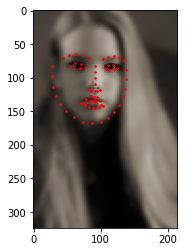
名稱和前四個標記點
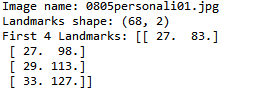

2. 讓我們編寫一個簡單的函式來顯示影象及其標記,並使用它來顯示示例。
def show_landmarks(image, landmarks):
"""Show image with landmarks"""
plt.imshow(image)
plt.scatter(landmarks[:, 0], landmarks[:, 1], s=10, marker='.', c='r')
plt.pause(0.001) # pause a bit so that plots are updated
plt.figure()
show_landmarks(io.imread(os.path.join('faces/', img_name)),
landmarks)
plt.show()
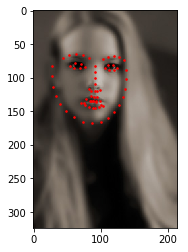
**
3. 定義一個數據集類
**
*torch.utils.data.Dataset is an abstract class representing a dataset. Your custom dataset should inherit Dataset and override the following methods:*torch.utils.data資料集是表示資料集的抽象類。自定義資料集應該繼承資料集並覆蓋以下方法:
len so that len(dataset) returns the size of the dataset.測量資料集的size
getitem to support the indexing such that dataset[i] can be used to get iith sample用·資料集的索引的得到資料集例子
定義一個類
class FaceLandmarksDataset(Dataset):
"""Face Landmarks dataset."""
def __init__(self, csv_file, root_dir, transform=None):
"""
Args:
csv_file (string): Path to the csv file with annotations.
root_dir (string): Directory with all the images.
transform (callable, optional): Optional transform to be applied
on a sample.
"""
self.landmarks_frame = pd.read_csv(csv_file)
self.root_dir = root_dir
self.transform = transform
def __len__(self):
return len(self.landmarks_frame)
def __getitem__(self, idx):
img_name = os.path.join(self.root_dir,
self.landmarks_frame.iloc[idx, 0])
image = io.imread(img_name)
landmarks = self.landmarks_frame.iloc[idx, 1:].as_matrix()
landmarks = landmarks.astype('float').reshape(-1, 2)
sample = {'image': image, 'landmarks': landmarks}
if self.transform:
sample = self.transform(sample)
return sample
4. 例項化這個類並遍歷資料示例。我們將列印前4個樣品的尺寸並顯示它們的標記。
face_dataset = FaceLandmarksDataset(csv_file='faces/face_landmarks.csv',
root_dir='faces/')
fig = plt.figure()
for i in range(len(face_dataset)):
sample = face_dataset[i]
print(i, sample['image'].shape, sample['landmarks'].shape)
ax = plt.subplot(1, 4, i + 1)
plt.tight_layout()
ax.set_title('Sample #{}'.format(i))
ax.axis('off')
show_landmarks(**sample)
if i == 3:
plt.show()
break
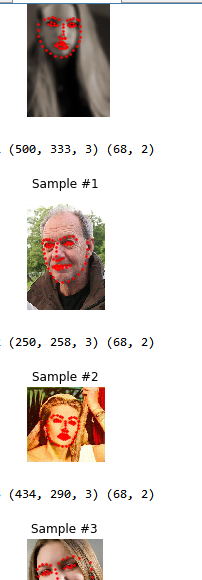
0 (324, 215, 3) (68, 2)
1 (500, 333, 3) (68, 2)
2 (250, 258, 3) (68, 2)
3 (434, 290, 3) (68, 2)
5. transform
從上面我們可以看到一個問題,樣品的尺寸不一樣。大多數神經網路期望得到固定大小的影象。因此,我們需要編寫一些預處理程式碼。讓我們建立三個轉換:
Rescale: to scale the image
RandomCrop: to crop from image randomly. This is data augmentation.
ToTensor: to convert the numpy images to torch images (we need to swap axes).
tsfm = Transform(params)
transformed_sample = tsfm(sample)
觀察這些變換是如何應用於影象和標記的。
class Rescale(object):
"""Rescale the image in a sample to a given size.
Args:
output_size (tuple or int): Desired output size. If tuple, output is
matched to output_size. If int, smaller of image edges is matched
to output_size keeping aspect ratio the same.
"""
def __init__(self, output_size):
assert isinstance(output_size, (int, tuple))
self.output_size = output_size
def __call__(self, sample):
image, landmarks = sample['image'], sample['landmarks']
h, w = image.shape[:2]
if isinstance(self.output_size, int):
if h > w:
new_h, new_w = self.output_size * h / w, self.output_size
else:
new_h, new_w = self.output_size, self.output_size * w / h
else:
new_h, new_w = self.output_size
new_h, new_w = int(new_h), int(new_w)
img = transform.resize(image, (new_h, new_w))
# h and w are swapped for landmarks because for images,
# x and y axes are axis 1 and 0 respectively
landmarks = landmarks * [new_w / w, new_h / h]
return {'image': img, 'landmarks': landmarks}
class RandomCrop(object):
"""Crop randomly the image in a sample.
Args:
output_size (tuple or int): Desired output size. If int, square crop
is made.
"""
def __init__(self, output_size):
assert isinstance(output_size, (int, tuple))
if isinstance(output_size, int):
self.output_size = (output_size, output_size)
else:
assert len(output_size) == 2
self.output_size = output_size
def __call__(self, sample):
image, landmarks = sample['image'], sample['landmarks']
h, w = image.shape[:2]
new_h, new_w = self.output_size
top = np.random.randint(0, h - new_h)
left = np.random.randint(0, w - new_w)
image = image[top: top + new_h,
left: left + new_w]
landmarks = landmarks - [left, top]
return {'image': image, 'landmarks': landmarks}
class ToTensor(object):
"""Convert ndarrays in sample to Tensors."""
def __call__(self, sample):
image, landmarks = sample['image'], sample['landmarks']
# swap color axis because
# numpy image: H x W x C
# torch image: C X H X W
image = image.transpose((2, 0, 1))
return {'image': torch.from_numpy(image),
'landmarks': torch.from_numpy(landmarks)}
6. Compose transforms
Now, we apply the transforms on an sample.
Let’s say we want to rescale the shorter side of the image to 256 and then randomly crop a square of size 224 from it. i.e, we want to compose Rescale and RandomCrop transforms. torchvision.transforms.Compose is a simple callable class which allows us to do this.
現在,我們對一個樣本進行變換。
假設我們想將影象的短邊縮放到256,然後從其中隨機裁剪一個224大小的正方形。我們想組合縮放和隨機裁剪變換。torchvision.transforms。Compose是一個簡單的可呼叫類。
scale = Rescale(256)
crop = RandomCrop(128)
composed = transforms.Compose([Rescale(256),
RandomCrop(224)])
# Apply each of the above transforms on sample.
fig = plt.figure()
sample = face_dataset[65]
for i, tsfrm in enumerate([scale, crop, composed]):
transformed_sample = tsfrm(sample)
ax = plt.subplot(1, 3, i + 1)
plt.tight_layout()
ax.set_title(type(tsfrm).__name__)
show_landmarks(**transformed_sample)
plt.show()
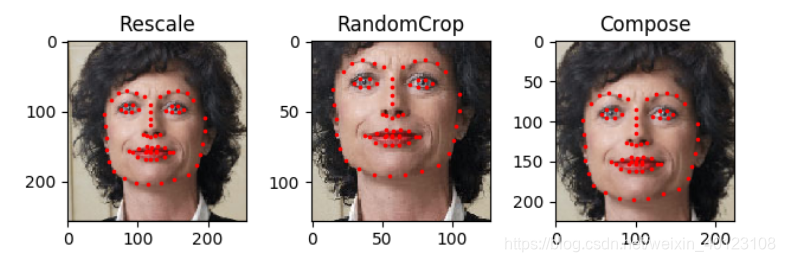
**
7. ITERATING THROUGH THE DATASET遍歷資料集
**
transformed_dataset = FaceLandmarksDataset(csv_file='faces/face_landmarks.csv',
root_dir='faces/',
transform=transforms.Compose([
Rescale(256),
RandomCrop(224),
ToTensor()
]))
for i in range(len(transformed_dataset)):
sample = transformed_dataset[i]
print(i, sample['image'].size(), sample['landmarks'].size())
if i == 3:
break
為了方便加批處理、打亂資料、使用多處理器並行載入資料。
使用函式torch.utils.data.DataLoader
dataloader = DataLoader(transformed_dataset, batch_size=4,
shuffle=True, num_workers=4)
# Helper function to show a batch
def show_landmarks_batch(sample_batched):
"""Show image with landmarks for a batch of samples."""
images_batch, landmarks_batch = \
sample_batched['image'], sample_batched['landmarks']
batch_size = len(images_batch)
im_size = images_batch.size(2)
grid = utils.make_grid(images_batch)
plt.imshow(grid.numpy().transpose((1, 2, 0)))
for i in range(batch_size):
plt.scatter(landmarks_batch[i, :, 0].numpy() + i * im_size,
landmarks_batch[i, :, 1].numpy(),
s=10, marker='.', c='r')
plt.title('Batch from dataloader')
for i_batch, sample_batched in enumerate(dataloader):
print(i_batch, sample_batched['image'].size(),
sample_batched['landmarks'].size())
# observe 4th batch and stop.
if i_batch == 3:
plt.figure()
show_landmarks_batch(sample_batched)
plt.axis('off')
plt.ioff()
plt.show()
break

0 torch.Size([4, 3, 224, 224]) torch.Size([4, 68, 2])
1 torch.Size([4, 3, 224, 224]) torch.Size([4, 68, 2])
2 torch.Size([4, 3, 224, 224]) torch.Size([4, 68, 2])
3 torch.Size([4, 3, 224, 224]) torch.Size([4, 68, 2])
來自官方網址
